|
|
|
Sort Order |
|
|
|
Items / Page
|
|
|
|
|
|
|
| Srl | Item |
| 1 |
ID:
171573
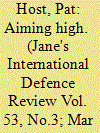

|
|
|
| 2 |
ID:
138228
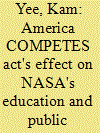

|
|
|
|
|
| Summary/Abstract |
NASA's Education and Public Outreach program performances have historically been poorly evaluated. The programs are fragmented and difficult to track which contributes to the difficulties faced by the United States' struggling education system. In response, the America Creating Opportunities to Meaningfully Promote Excellence in Technology, Education and Science Reauthorization Act of 2010 (America COMPETES) was passed in an effort to streamline federal efforts in Science, Technology, Engineering, and Math education (STEM) and keep the American technical workforce competitive in the global market.America COMPETES' impact on NASA's role in STEM education made little positive changes. The Act's requirements perpetuate misguided STEM education evaluation methods. Funds appropriation marginalize NASA from meaningful K-12 education interactions. Portions of the implementation steps are counter-productive to NASA's public image.
|
|
|
|
|
|
|
|
|
|
|
|
|
|
|
|
| 3 |
ID:
119770
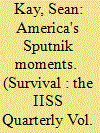

|
|
|
| 4 |
ID:
142590
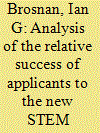

|
|
|
|
|
| Summary/Abstract |
In 2014, the U.S. Office of Personnel Management's Presidential Management Fellowship (PMF) Program initiated a pilot, PMF STEM, to bring recent graduates with advanced degrees in science, technology, engineering, and mathematics (STEM) fields into federal service. The NASA Office of Human Capital was closely engaged, and the pilot was a welcome new avenue for STEM hiring. Here, I ask how the Finalists in this new STEM program fared relative to traditional PMF finalists. I find that the rates at which traditional PMF and PMF STEM Finalists in the Class of 2014 received their first appointment offers were significantly different (p = 0.0315), and PMF STEM Finalists were initially offered appointments at higher rates than the PMF Finalists. However, this advantage disappeared over time, possibly because the remaining PMF STEM Finalists were not a good fit to the available STEM opportunities. When the appointment period for the Class of 2014 closed, 58% of PMF STEM Finalists and 72% of PMF Finalists had received appointment offers. Although a smaller proportion of PMF STEM Finalists received offers in 2014, their offer rate was consistent with the long-term average. I briefly discuss the NASA context for these results.
|
|
|
|
|
|
|
|
|
|
|
|
|
|
|
|
| 5 |
ID:
107704
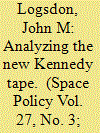

|
|
|
| 6 |
ID:
184509


|
|
|
|
|
| Summary/Abstract |
We have entered a new space era, projecting all the Earth’s great power pathologies—ambition, fear, and greed—into the heavens.
|
|
|
|
|
|
|
|
|
|
|
|
|
|
|
|
| 7 |
ID:
122532


|
|
|
|
|
| Publication |
2013.
|
| Summary/Abstract |
Between January 1969 and the summer of 1975, NASA received over eight million letters and petition signatures supporting the right of American astronauts to free religious expression in space. Prompted by Madalyn Murray O'Hair's complaints about the reading of Genesis during the flight of Apollo 8, the petition campaign points to the complex ambivalent relationship between religious Americans and their nation's space program. The Genesis reading had provided reassurance that the program, with its secular motivations, its instrumental culture, and its designs upon God's very heavens, was not hostile to faith. But what if NASA now yielded to O'Hair? The petitions flowed in the eschatological anxiety that the sacred space of the skies might be cleared of Christian speech.
|
|
|
|
|
|
|
|
|
|
|
|
|
|
|
|
| 8 |
ID:
083779
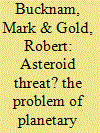

|
|
|
|
|
| Publication |
2008.
|
| Summary/Abstract |
The threat of collision from asteroids and comets calls for a three-step approach to mitigating the risks: first, find and track objects that are potentially hazardous to the Earth; second, study their characteristics so as to understand which mitigation schemes are likely to be effective; and third, test various deflection techniques to ascertain the best way to adjust the orbits of asteroids and comets, and possibly field a planetary-defence system. Each of these steps would benefit from international cooperation or agreement.
|
|
|
|
|
|
|
|
|
|
|
|
|
|
|
|
| 9 |
ID:
113041
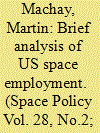

|
|
|
|
|
| Publication |
2012.
|
| Summary/Abstract |
Space policy is an area of industrial economic policy. The space economy would vanish without the active role of the state. Although space may appear exotic to economist, it is not impossible to provide a quick economic insight into one of the most important aspects of all economic activities - the people employed. The space industry can attract employees from other industries in two ways. First, according to individual preferences and motivations. Second, on the basis of higher wages. Statistical evidence suggests the latter is more common. Moreover wages do not reflect productivity. NASA employees earn much more than employees in law or medicine. This does not match the social importance of these activities. Space employs many more people that stated by the OECD. Taking all activities together space employs almost half a million people in the USA. $1 billion given to NASA creates up to 24 000 vacancies in the space industry and also provides room for another 40 000 in the space economy in the long run. Current changes to the US national space programme suggest a decrease of $1.6 billion per year, implying a loss of up to 39 000 jobs.
|
|
|
|
|
|
|
|
|
|
|
|
|
|
|
|
| 10 |
ID:
105510
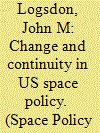

|
|
|
|
|
| Publication |
2011.
|
| Summary/Abstract |
2010 saw both the unveiling of a new US National Space Policy and the announcement of a fundamentally different strategy for US human spaceflight that would move from the NASA-government-led Apollo-style approach to a greater reliance on the private sector and international cooperation. This viewpoint puts forward arguments on why change in the US approach to human spaceflight is needed, while acknowledging that achieving it in the face of vested interests and threats to jobs and livelihoods is extremely difficult. It suggests that greater US recognition of the need to ensure the sustainability of space activity (by addressing debris, radio-frequency interference and potential deliberate disruption of spacecraft), and an apparent willingness to countenance international norms to govern space activities, could be the new policy's most lasting heritage.
|
|
|
|
|
|
|
|
|
|
|
|
|
|
|
|
| 11 |
ID:
119888
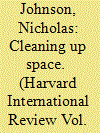

|
|
|
| 12 |
ID:
119885
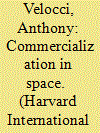

|
|
|
| 13 |
ID:
137563


|
|
|
|
|
| Summary/Abstract |
Starting with the Soviets’ launch of Sputnik in 1957, early space missions were funded exclusively by national governments, and for good reason: going to space was astronomically expensive. Setting up a successful space program meant making major investments in expertise and infrastructure, along with tolerating a great deal of risk—which only the superpowers could do. NASA’s Apollo program, for instance, employed 400,000 people, cost more than $110 billion in today’s dollars, and resulted in the death of three skilled astronauts. Not surprisingly, then, the legal framework that developed as the space race intensified was government-centric. In 1967, the United States, the Soviet Union, and many other countries signed the Outer Space Treaty, which set up a framework for managing activities in space—usually defined as beginning 62 miles above sea level. The treaty established national governments as the parties responsible for governing space, a principle that remains in place today.
|
|
|
|
|
|
|
|
|
|
|
|
|
|
|
|
| 14 |
ID:
154949
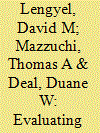

|
|
|
|
|
| Summary/Abstract |
The February 2003 loss of the space shuttle Columbia on mission STS-107 was a mishap that stunned both NASA and the world. This research examines the pre-NASA and post-NASA decision-making modalities and risk acceptance behavior for the safe and reliable operation of the space shuttle through the lens of hazard analysis. Interviews with NASA administrators and senior Space Shuttle Program managers bring back to life their views from the 2003 through 2005 timeframe, during which NASA returned the space shuttle back to a flight status. Lessons from their effort have broad applicability to other organizations recovering from—and attempting to prevent—a major accident.
|
|
|
|
|
|
|
|
|
|
|
|
|
|
|
|
| 15 |
ID:
122072


|
|
|
| 16 |
ID:
121656
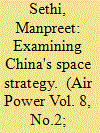

|
|
|
| 17 |
ID:
102225


|
|
|
| 18 |
ID:
114246
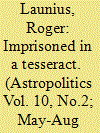

|
|
|
|
|
| Publication |
2012.
|
| Summary/Abstract |
This essay focuses on the decision by senior National Aeronautics and Space Administration (NASA) officials at the creation of the agency to focus its efforts on human spaceflight, Moon and Mars missions, and human settlement of the solar system. Its leaders made a conscious decision to downplay space applications projects, exclusive of technological research and development, and eschew operational activities. They did so in favor of concentrating on the human exploration and development of space. In so doing, NASA fell into the prestige trap that dominated this mission in the 1950s and early 1960s. At sum it was a tesseract, a four-dimensional object, which locked NASA into a quest for ever greater space spectaculars featuring human involvement. Power and prestige, therefore, has cast a long shadow on the space agency, forcing it into a series of programs that have been oversold and undervalued.
|
|
|
|
|
|
|
|
|
|
|
|
|
|
|
|
| 19 |
ID:
118486
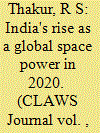

|
|
|
| 20 |
ID:
142104
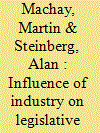

|
|
|
|
|
| Summary/Abstract |
This article explores economic factors that help to explain Congressional support for NASA Authorization Acts and issues of U.S. federal space funding. Three economic factors related to political opportunism are identified and discussed in detail. Across the board, NASA Centers are a significant factor in shaping voting preferences, suggesting that the NASA presence itself plays an important role in influencing legislators. Meanwhile, other forms of economic opportunism based on the relative importance of the space and aircraft manufacturing industries in a given state and the amounts of NASA procurements are factors, but only in a more limited sense. This supports the concept that economic opportunism does influence legislative voting behavior on NASA Authorization Acts, though the bulk of the impact appears to be indirectly via NASA centers.
|
|
|
|
|
|
|
|
|
|
|
|
|
|
|
|
|
|
|
|
|